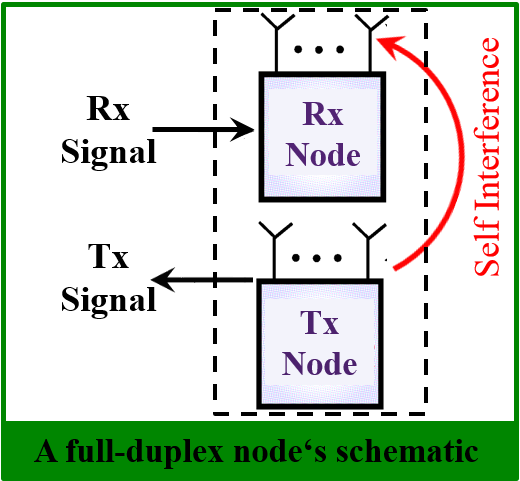Achievable Rates for Full-Duplex Wireless Communication

Bi-directional communication within the same channel. Inevitable loopback interference signal (red arrow) must be suppressed.
What is full-duplex communication?
A full-duplex communication is defined as the capability to transmit and receive at both same time and same frequency. Using the same resource for transmitting and receiving is advantageous in various aspects (e.g., resource efficiency, access layer functionality, round trip time), nonetheless, it has been considered as infeasible due to the strong loopback interference. Recently, applying specialized cancellation techniques has brought acceptable level of isolation between the two directions of communication and hence encouraged further research in this area.
Active research directions
- How to achieve better suppression for the loopback signal? (e.g., antenna design, isolation, RF cancellation, digital domain techniques)
- Which use-cases may benefit from full-duplex? How to update the classic designs to achieve higher performance? (e.g., new design for resource allocation, transmission strategies)
- What does this new paradigm mean for higher layers? (e.g., no hidden/exposed terminal problem, better sensing capability, reduced round trip time)
Our current focus
- Distinguishing appropriate physical layer scenarios to apply full-duplex
- Bounds for achievable full-duplex gains in presence of limited dynamic range
- Methodology and rethinking the classic designs with the new paradigm
Related publications
- O. Taghizadeh, R. Mathar, Cooperative Strategies for Distributed Full-Duplex Relay Networks with Limited Dynamic Range, Proceedings: Wireless for Space and Extreme Environments (WiSEE), 2014 IEEE International Conference on, Noordwijk, Netherlands, December 2014.
- O. Taghizadeh, R. Mathar, Robust Multi-User Decode-and-Forward Relaying with Full-Duplex Operation, Proceedings: The Eleventh International Symposium on Wireless Communication Systems (ISWYS 2014), Barcelona, Spain, September 2014.
- O. Taghizadeh, R. Mathar, Full-Duplex Decode-and-Forward Relaying with Limited Self-Interference Cancellation, Proceedings: 18th International ITG Workshop on Smart Antennas 2014 (WSA 2014), Erlangen, Germany, March 2014.
- O. Taghizadeh, R. Mathar, Interference Mitigation via Power Optimization Schemes for Full-Duplex Networking, Proceedings: 19th International ITG Workshop on Smart Antennas (WSA 2015), Ilmenau, Germany, March 2015.
- J. Zhang, O. Taghizadeh, and M. Haardt, Robust Transmit Beamforming Design for Full-Duplex Point-to-Point MIMO Systems, Proceedings of the Tenth International Symposium on Wireless Communication Systems (ISWCS 2013)
- J. Zhang, O. Taghizadeh, and M. Haardt, Joint Source and Relay Precoding Design for One-Way Full-Duplex MIMO Relaying Systems, Proceedings: Proceedings of the Tenth International Symposium on Wireless Communication Systems (ISWCS 2013)
- J. Zhang, O. Taghizadeh, and M. Haardt, Transmit Strategies for Full-Duplex Point-to-Point Systems with Residual Self-Interference WSA 2013 - 17th International ITG Workshop on Smart Antennas
- J. Zhang, O. Taghizadeh, J. Luo, and M. Haardt, Full Duplex Wireless Communication with Partial Interference Cancellation , Proc. of the 46th Asilomar Conference on Signals, Systems, and Computers, (Pacific Grove, CA), pp. 1295-1299, Nov. 2012
Contact
Omid Taghizadeh ***
Aktuelle Informationen gemäß Art. 13 DS-GVO:
Datenschutzhinweis ***
Impressum ***

